|
A pair of exhibitions at the Bowdoin College Museum of Art in Brunswick, Maine, takes a look at the theme of using visual expression to
pursue aesthetic ideals of resolution – both as an artistic principle and as a conceptual goal. Art and Resoultion 1900 to Today is an ambitious show featuring a
wide range of photographs, prints, and other media to explore the dual meaning of “resolution,” as both coming-into-view and overcoming conflict. Focusing on the
turbulent 20th and early 21st centuries, the works selected by curator Ellen Tani depict artist’s responses to world wars, disasters, financial collapse, environmental
degradation, and violations of human rights and chronicle the individual solutions each artist arrived at in his work. An edgy, elusive, thought-provoking exhibition, it
leaves the viewer with a stronger impression of the struggle of the artistic process than of orderly outcome. As a kind of refreshing coda to the major display, the small
Becker Gallery is devoted to a display entitled Where Do I Go from Here? Snapshots of Twentieth Century Life, a collection of 150 photo miniatures by amateurs from the
collection of Peter Cohen, which, when assembled artfully as they are here, create a stirring, warm narrative in the vernacular.
Housed in three large galleries on the ground floor of the museum, Art and Resolution begins with some arresting contemporary photographs. A pair of haunting portraits by American/Iranian artist Shirin Neshat speaks to the ravages of a region in conflict – not by depicting epic events, but rather by looking deep into the eyes of two subjects from the photographer’s “My House Is on Fire” series.
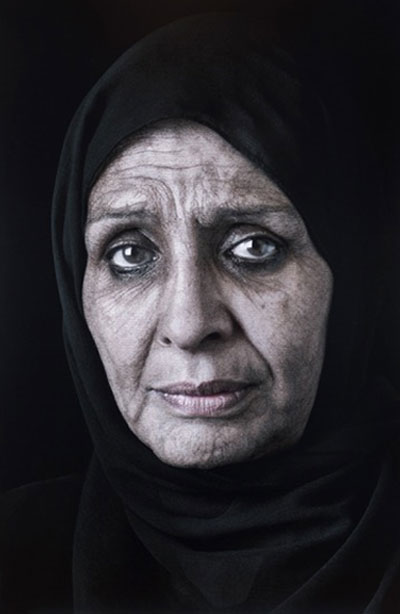
The first, “Ghada” is a veiled woman, whose lovely, lined face and large questioning eyes confronting the camera, seem to
ask for some explanation for the swirling chaos of her life, at the same time that her dark, hieratic figure in its quiet stasis,
imposes a controlled calm and tension on the image.
A second portrait from this series is of an old man, “Sayed,” whose gaunt weathered visage similarly speaks of survival and pain.
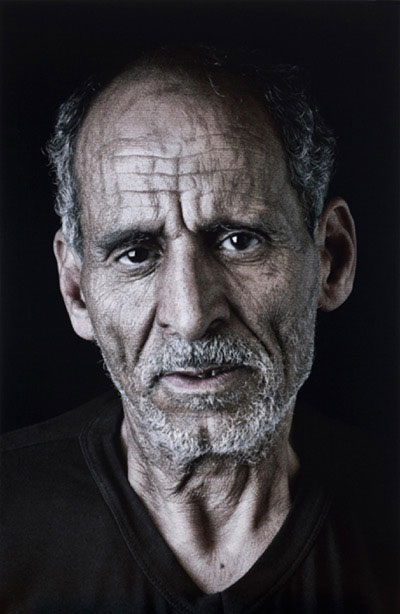
Complementing this series are some striking black-paper cut outs by African-American artist Kara Walker from her illustrations for Freedom Fable, as well as a large scale
dramatic image of a black woman tumbling through space in an inverted position. The delicacy of the medium contrasts
vibrantly with the kinetic sense of the work and its message of turmoil.
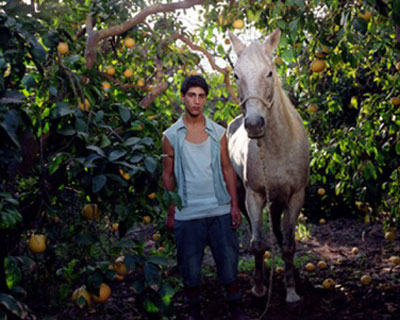
Several other standouts in the first gallery are the large-scale chromogenic prints by Israeli photographer Adi Nes, which
depict portaits and genre scenes of young Israelis. Dominating the gallery is a staged image of an Israeli male soldier flexing his muscle in a pose that conjures up the
muscular works of both the Renaissance painters and their stylized counterparts in artists like Rockwell Kent. Other
images include that of a “Young Jew,” a handsome youth with curly hair, sensuous lips, and an inscrutable smile or a young
man holding a giant dead white bird upside down – a grotesque symbol of the destruction of peace. There is an homoerotic overtone to these works, similar to that found in
Michelangelo, and the sitters clearly represent a male ideal of beauty for the artist. In the poignant, understated genre
scene, “The Village,” two Israeli soldiers, a young woman and a man are depicted in conversation with an older couple. The
female soldier’s hand softly touches the gray-haired woman’s shoulder, and one can intuit that the news she imparts is grave.
The second gallery features more abstract conceptions. Joseph Dandowski is represented by two series of
black/white still lifes, “Gutters” and “Manholes” which use the lens to visually express the rhythms pulsating within
these quotidian objects. In a similar vein, Maine artist Yvonne Jacquette, is represented by a large aerial photograph of the
controversial Wiscasset nuclear plant – a tangle of iridescent geometric shapes, and Emmet Gowin takes another aerial
image of miningscapes in Utah- vast desolate images. A parallel use of form to embody an almost musical dynamic is
found in the exhibition’s single sculpture, “Raumplastik” by Dusseldorf-born artists Norbert Kricke – an expressive
explosion of fine silver metallic rods dancing swirling from a central core.
Several large prints from Robert Rauschenberg’s Crops series
represent the artist’s interest in overlay of word and abstract image, while perhaps the most unusual series, Black Shanga, comes from British-born Chris Ofili.
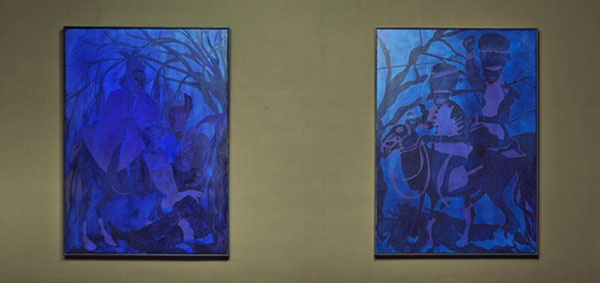
In these dark, shadowy blue-silver toned paintings, hidden figures gradually emerge from the moonlit glow. The viewer
accustoms himself to the light, as it were, and slowly sees fantastical creatures, animal grotesques and totems, fairy-like
figures, and disjointed fragments of faces and bodies floating through space. There is an element of black magic that is haunting and unsettling and yet commands the viewer to
stare into the abyss of the work.
African-American artist Leon Golub’s 1998 Facings is a large print with the faces of three men and three women. The men
are genial and smiling, the women anguished, and the pairing of the two suggests a world of gender tension, confrontation and conflict.
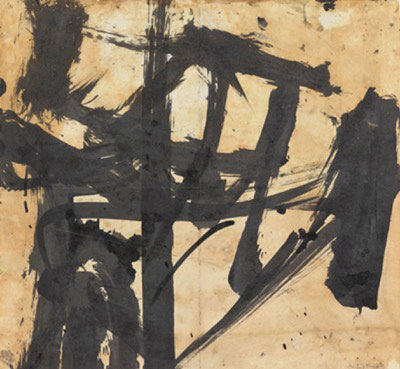
In counterpoint Franz Kline’s bold ink drawing of an abstract, almost calligraphic series of brush strokes suggests only the
dynamic of confrontation rather than the actual human embodiment.
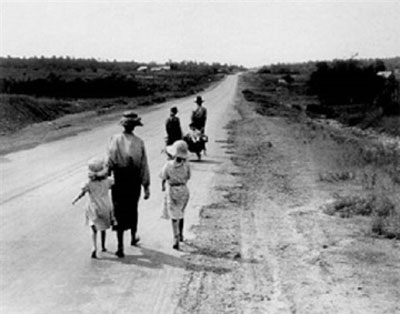
Moving into the last gallery, the works return to the documentary, the figurative, and the narrative. There is a
powerful quartet of Goya etchings, hung side by side with ACME news photographs of the holocaust,and two poignant
Dorothea Lange depression photos, “Homeless Family” and “Ex-tenant Farmer on the Road.”
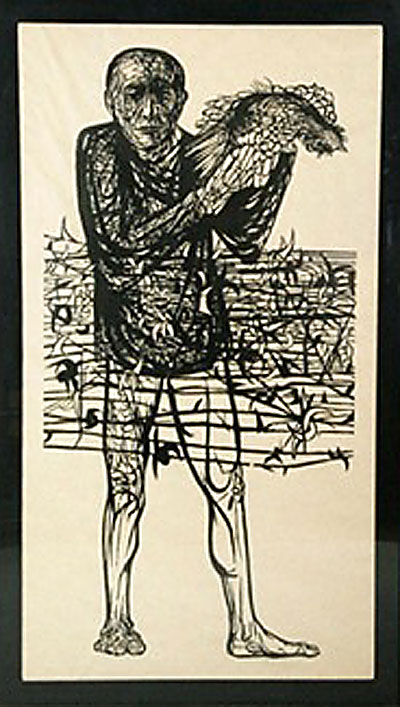
These segue into the towering woodcut image by Leonard Baskin, “Man of Peace,” with the subject holding a huge dove
against a background of barbed wire and then into several early 20th century oils, including the compelling John Sloan
oil, “The Window,” in which a woman leans forward from a red brick tenement window, contemplating the unseen street
scene below. Like so many of the images in the exhibition, she is an inscrutable presence, a figure frozen in time and space.
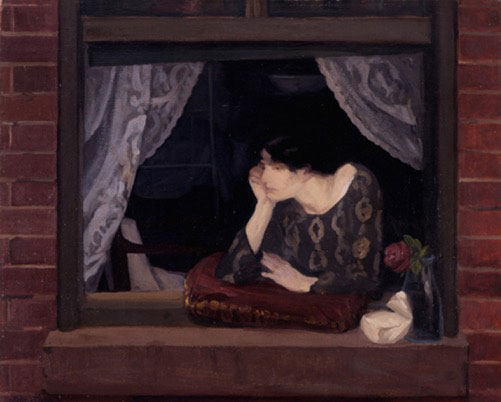
Before leaving the principal exhibition, one can detour into the tiny room housing the 150 snapshots of 20th century life.
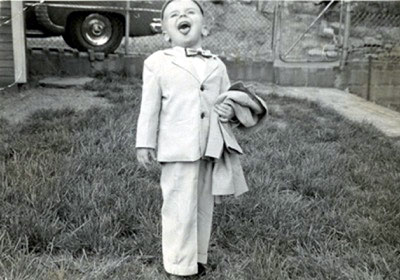
If the previous three galleries raise bold, disturbing questions, this room proves an oasis of calm nostalgia. These are
photographs in the vernacular, which speak to the little daily activities of ordinary people – the very kinds of things we all
document on the spur of the moment in an attempt to make time standstill. All silver gelatin prints in miniature (3x5”)
and arranged in several chronological groupings, the exhibit takes on the quality of family albums being attentive to
documenting a racial mix of subjects. There are scenes of childhood and adolescence depicting toddlers eating, blowing
out birthday candles, sitting in a wash tub, playing with a baby doll, idling on a dock, outfitted in Sunday finery, mournful faces from an orphanage, and clowning twins.
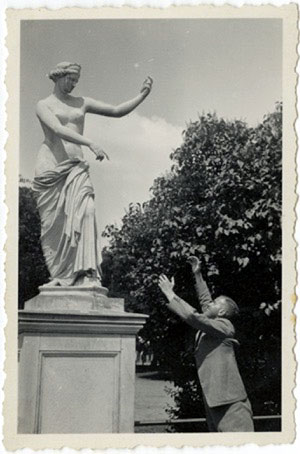
The sections on growing up and escapades, demonstrate the way the camera has preserved high points of our individual
journeys: scenes of camping, taking a train ride, mountain climbing, a young soldier posing proudly in uniform, young men testing their physical prowess by doing gymnastics or
diving. Or there are the images of more relaxed fun: groups at the beach, girls at sleepovers. These are followed by images
of young adulthood capturing many different relationships from romantic and married couples to friends and colleagues
. There are snapshots of a pregnant woman, of lovers courting, rural and city parents and their children, mothers and
daughters, grandparents with babies. The last image in the collection is of a son standing behind his aged father on a dramatic Western bluff overlooking a majestic canyon; the
younger man’s hand is raised in a gesture of acknowledgement (not dissimilar to the famous Asher B. Durand painting) of the vastness if Nature and the
minuteness of man. It provides a fitting conclusion to this mini-journey, which, despite the size and understated nature of the images, feels monumental for the distance covered.
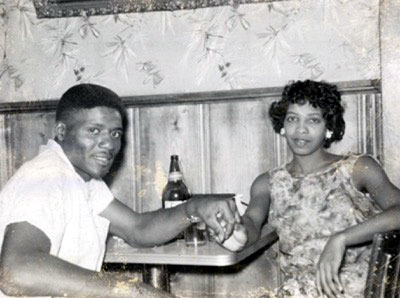
Bowdoin College Museum’s goal with these two (and several other displays on view now) is to examine the way in which
photography and other visual media are able to turn the lens on human emotion and dynamics and seek through form to shape feeling into idea. Art and Resolution grapples with this
lofty, sometimes esoteric purpose, and it is unsparing enough to suggest that perhaps resolution is more an ideal than an eventuality. Where Do I Go from Here? makes no such grand
claims to conceptualizing. Rather the snapshot albums offer an existential antidote to the idea-driven nature of many of
the works in the major exhibition. Instead, they depict images which revel in the moment, and in doing so, they make time disarmingly stand still.
All photos courtesy of Bowdoin College Museum of Art
|